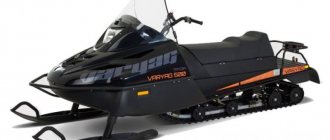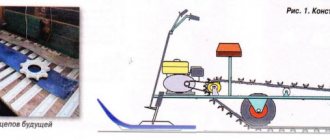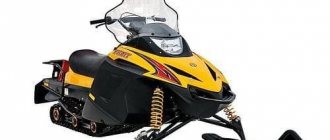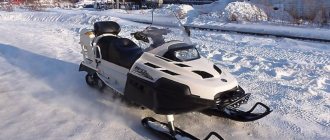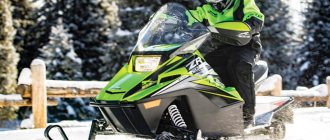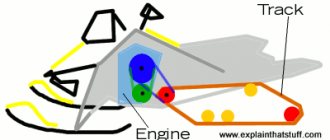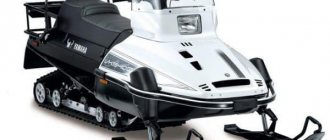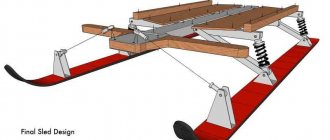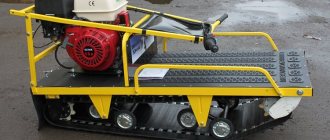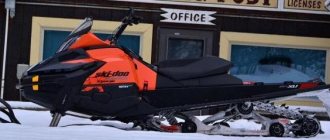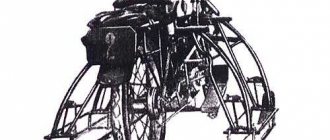Do you want more cool experiences, ease of use, and comfort during winter adventures? Discover snowmobiles! To prevent the equipment from becoming a disappointment, we tell you what to look for when buying and how to choose the right model.
When you've been sitting at home for almost a whole year due to a pandemic and can't travel, thrills are especially lacking. Winter has come, and do you think that you can forget about adventures until summer comes? No matter how it is! The frosty months are ahead, which means it's time for exciting snow adventures. Why not take a trip on a brand new snowmobile? Some models will cost you less than a trip for two to hot countries, and will bring you many times more pleasure. Experts from the online snowmobile store Globaldrive told us how to choose a snowmobile that won’t let you down, and what they are like.
Types of snowmobiles
To the uninitiated, it may seem that all snowmobiles are the same. In fact, there are five varieties of them: transport (utilitarian or traction), tourism, mountain, sports and crossovers. Why so many? Different types of snowmobiles have different characteristics: power, speed, maneuverability, maneuverability, comfort and, of course, dimensions vary. Agree, trying to set a speed record on a transport snowmobile is a dubious idea.
Transport snowmobiles
ideal for cargo transportation. Their main advantage - cross-country ability - is provided by wide and long tracks. Such snowmobiles can easily carry two people, and for a comfortable trip they have everything you need: a comfortable backrest for the passenger seat, rear-view mirrors, a spacious trunk that can easily accommodate equipment. In addition, this type of snowmobile is usually equipped with a towbar.
Great attention is also paid to comfort and cross-country ability in the production of touring snowmobiles.
, because riders spend more than one hour on them. Touring snowmobiles are almost as powerful as transport snowmobiles, but have greater speed.
Snowmobile PM Vector 551
Meanwhile for sport snowmobiles
comfort and cross-country ability are not at all the main thing: speed and weight are more important. Such priorities determine the equipment: a powerful engine, energy-intensive suspension, low weight, narrow and short tracks, which are best suited for movement in shallow snow.
Mountain snowmobiles
In many ways they resemble sports ones. Mountain models also have a powerful engine and are lightweight, making these snowmobiles very maneuverable. The tracks are just as narrow, but longer than those of sports tracks - reaching four meters. In addition, they are equipped with lugs, which can significantly increase grip on the surface.
2. Snowmobile design
We should dwell in a little more detail on the features of the snowmobile. Modern models are made primarily with one rear track and two front steering skis. This support allows for high stability. Unlike versions with two tracks and one ski, these snowmobiles are more maneuverable. The skis, made of durable, light and flexible plastic, have a handle (thanks to it you can turn the skis in the snow or pull out a snowmobile) and a skate that increases controllability and is capable of cutting not only dense snow, but also ice. The tracks are solid belts with lugs.
Engines for snowmobiles are gasoline, injection, two- or four-stroke, liquid- or air-cooled. The body of a snowmobile is often made of steel, durable aluminum alloys or fiberglass. Other important components of every snowmobile are the transmission and suspension.
All about snowmobiles and all about snowmobiles
The first snowmobiles moved from many kilometers of conveyor lines to even more many kilometers of snowy expanses in the mid-sixties of the last century. And over time, the glorious family tree of snowmobile technology gave five branches.
Snowmobile models
Depending on their technical characteristics and the purposes for which they are focused, all models are divided into tourism, sports, mountain, utilitarian and children's.
Sports snowmobiles, the supreme deity of all snowmobiles, are created as if specifically in order to cut through the icy surface of a lake at enormous speed or weave around the turns of prepared tracks. Usually not burdened by an electric start and reverse gear, these “snowballs,” as their owners affectionately call them, are designed for one rider and are capable of accelerating to 200 km/h or more.
The energy-intensive and rigid suspension of these models allows them to fly over uneven surfaces at impressive speeds and make jumps. Limitations in cross-country ability are due to the short track - it is not recommended to ride them on loose or deep snow.
The dimensions and weight of touring models are significantly larger than those of their sports relatives. There is enough space on board for both the captain of the snowmobile cruiser and the passenger. Comfort all the way is provided by soft, adjustable heated seats, and handling is bolstered by standard reverse, electric start and a plush suspension.
The long but narrow tracks of the “tourist” add speed to it, but impose serious restrictions on cross-country ability. The destiny of tourist snowmobiles is well-groomed trails. It can be very difficult to get such a colossus out of snow captivity. For drivers who are not experienced in speed and extreme sports and lovers of family recreation, this snow horse is best suited.
The most “passable” snowmobiles, specially designed for moving across relief terrain, are mountain snowmobiles. With consistently high handling and cross-country ability, these “snowballs” are quite demanding of the driver’s skill. They become truly mountain and all-terrain only in the hands of an experienced snowmobiler. It is these “snowballs” that make it possible to splash out a huge portion of adrenaline and get the maximum amount of unforgettable sensations for fans and connoisseurs of extreme sports. Moreover, in the conditions of our vast North, mountain snowmobiles can be used for a longer period of time, unlike other machines. The skiing season starts at the beginning of November and ends at the end of April next year.
Standing firmly on their wide tracks, utilitarian snowmobiles are surrounded by an aura of reliability and practicality. Ideal plain explorers, called whitetrucks in English, will take not only you where you need to go, but also a load weighing up to 500 kg. With speed, things are a little worse - 120 km/h is the upper limit for most windtrucks. Early models of utilitarian cars could not boast of a comfortable interior, but modern ones come close to the level of tourist cars in terms of comfort. To all other advantages, let’s add the exceptional usefulness of windtrucks in hunting and fishing - there simply cannot be any other choice.
Everything about children's snowmobiles is clear without further ado - a smaller and speed-limited version of an adult snowmobile, to the delight of the major child, who is at the happy age of nine to twelve years.
By the way, the starting cost of a good imported snowmobile is 300 thousand rubles. Movement from this amount is usually only possible upward. There are few compromises: you can either purchase domestic analogues that are significantly inferior in price, or look for a used “foreigner”.
All about snowmobile engines
The beating motor in every snowmobile can be quite correctly compared to a heart. Only instead of chambers and ventricles, it has two- or four-stroke power. Experts consider four-stroke engines to be more preferable for a number of reasons: they have an increased service life, they “eat” significantly less gasoline, are less noisy and, moreover, are free from a common disease that affects their two-stroke counterparts - frequent failure of spark plugs.
The only serious problem with four-stroke engines (the possibility of overheating) must be protected by the cooling system. If the cooling system fails (this can happen as a result of long driving on a dry road or on ice), then in the most “smart” snowmobile models the engine turns off automatically to avoid wear. In slightly less intelligent “snowballs”, a warning light is provided for such a case.
Note to economical drivers: one of the most economical four-stroke engines of our time, Suzuki, depending on the speed of movement on one tank (60 liters of gasoline), allows you to cover a distance of 450 or even 500 km.
Advice: It is better to conduct a pre-sale inspection of a snowmobile with the support of a seasoned snowmobile specialist so that he checks all the important components of the machine for suitability for further use in the harsh Siberian winter.
All about rights and equipment
Riding a wild horse is a dangerous undertaking. Taming a snowy horse is much easier. A cowboy hat and boots with spurs can easily replace a Category A tractor driver's license. You can get them in specialized schools aimed at teaching everyone over 18 years of age how to drive snowmobiles, ATVs and other related equipment.
Those who have obtained the coveted crust are advised to seriously consider their equipment before saddled up on a snowmobile. Protection is vital - both from the cold and from the vicissitudes of fate. Helmets, protective gloves, jackets and motorbike boots, suits - all these elements not only protect against treacherous winds and accidental falls, but also turn a person sitting on a snowmobile horse into a knight clad in futuristic armor and add romance and charm to the event. True, they are not cheap, but something tells me that potential buyers will not stand by the price.
Engine power
This parameter is not always indicated in the specifications, limited to engine size. In such a case, it is worth remembering that the working volume of most engines is at least 550 cubic centimeters. Otherwise, they are divided into two types: two-stroke and four-stroke. The first option is suitable for utilitarian snowmobiles (they are easy to repair) and mountain models (two-stroke engines are relatively light). Four-stroke engines provide better performance and boast superior environmental performance.
Snowmobile weight
Did you decide to get behind the wheel of a snowmobile for the first time? Choose lightweight and maneuverable mountain or sports models to get more emotions and develop decent speed. If such a snowmobile gets stuck, it will not be difficult to return it to the track, even alone. Heavy touring and utility snowmobiles are more difficult to control, especially when cornering. In addition, due to the fact that they develop a relatively low speed, you risk being disappointed in your vehicle after the first trip on it. Heavy models of winter equipment are suitable for lovers of measured long-distance rides. If you are still in doubt about your choice, sign up for a test drive at the dealer.
Snowmobile device
We should dwell in a little more detail on the features of the snowmobile. Modern models are made primarily with one rear track and two front steering skis. This support allows for high stability. Unlike versions with two tracks and one ski, these snowmobiles are more maneuverable. The skis, made of durable, light and flexible plastic, have a handle (thanks to it you can turn the skis in the snow or pull out a snowmobile) and a skate that increases controllability and is capable of cutting not only dense snow, but also ice. The tracks are solid belts with lugs.
Engines for snowmobiles are gasoline, injection, two- or four-stroke, liquid- or air-cooled. The body of a snowmobile is often made of steel, durable aluminum alloys or fiberglass. Other important components of every snowmobile are the transmission and suspension.
Snowmobile price
The price range for snowmobiles is impressive: you can find copies for less than a hundred thousand rubles (they will be second-hand and of rather dubious quality), or for a couple of millions. Beginners should not rush to extremes - it is better to choose something in between. On the one hand, you definitely won’t regret the money spent, on the other hand, you’ll get a comfortable ride for a reasonable amount. Even if you find that snowmobiles aren't your passion, mid-range models will always be easier to resell.
Transportation and storage
It is clear that you cannot do with a snowmobile the same as with a car - sit down and immediately go. Even if it’s winter outside, you will need preparation and a little knowledge. The best way is to use cargo transportation services: specialists will load your vehicle into a car trailer or the back of a pickup truck - the main thing is to ensure maximum immobility for it. True, this option is suitable for small and light models. In pickup trucks, snowmobiles are placed on a special platform in the back, and in minibuses and gazelles, they can simply be placed and secured. If you plan to regularly take your snowmobile to a riding area outside the city, then it is better to buy a suitable trailer. Since snowmobiles have tracks and skis instead of wheels, make sure you have something that will securely grip the tracks; a regular ramp won't do.
At the end of the season, you can’t just put the snowmobile in the garage - it needs reliable preservation. Disconnect the battery, clean it from dirt and charge it so that the contacts do not oxidize and the lead plates are not destroyed. Coat any parts that may be susceptible to corrosion with preservative. Otherwise, the variator may fail, the cables and pads will begin to jam, the brake calipers may jam, and the track rollers may even fail. Empty the gas tank - gasoline remaining in it for a long time will lose light fractions, which will deteriorate the quality of the fuel and lead to increased load on the engine. The engine, by the way, also needs to be treated with a preservative, remove the spark plugs and pour the preservative into the combustion chamber. This must be done so that the first start after preservation does not occur during oil starvation, otherwise the engine life will sharply decrease. Don't forget to lubricate the suspension if you don't want to hear squeaks next season. By the way, it is recommended to carry out preservation on a warm engine: this is the only way the mechanisms and components are movable and not subject to rust.
New or used snowmobile
With new snowmobiles from the dealer, everything is clear. In this case, they will always competently tell you about the features of each model, help you make a choice and show you all the pitfalls. If you decide to take the car from your hands, the former owner is unlikely to notify you of all possible shortcomings. To avoid getting a pig in a poke, first of all evaluate the appearance of the snowmobile. There should be no dents or abrasions on the external elements of the body, and no cracks on the frames. Don't forget about the slides and fasteners. Also, do not opt for snowmobiles if defects and damage are clearly visible on their tracks: non-removable tracks cannot be repaired at all, they will have to be replaced entirely. Even minor repairs are most likely not included in your plans. Paying money for an extra headache is not our method.
Now about what cannot be seen with the naked eye. Take a compression gauge and check the pressure in the engine cylinders - it should be the same (at least approximately). Ask the seller to arrange a test drive and listen to any extraneous noises - ideally there should be none.
Then you should pay attention to the front suspension and variator. The load on them is constant (and significant), so look at the geometry of the suspension and its components. If you notice dark stripes, scuffs and cracks on the variator, this only means one thing: it will have to be replaced soon. Be sure to look inside the transmission and make sure the oil and coolant are the correct color and at the correct level.
Don't hesitate to ask the seller questions. Ask about how he cared for the snowmobile, whether he preserved it at the end of the season, and in what conditions he operated it. Remember that official dealers usually have a full diagnostic service - use it.
Specifications
Description and technical characteristics of Buran-640:
| Front suspension type | Spring |
| Rear suspension type | Independent |
| Number of front springs | 1 |
| Number of tracks | 2 |
| Tension mechanism | Screw |
| Gearbox model | Variable speed drive |
| Number of gears | 4 |
| Reverse | Eat |
| Brake system type | Disk |
| Brake drive | Mechanical |
| Powertrain starting system | Manual, electric starter |
| Ignition | Contactless |
| Lubrication system | Combined (gasoline and oil) |
| Number of seats | 2 |
| Permissible towed load weight | 250 kg |
| Speedometer | Eat |
| Heated grips | Eat |
| Headlight | 55/60, halogen |
| Taillight | LED |
| Piston stroke | 7 cm |
| Fuel used | Gasoline AI-92, AI-76, AI-80 |
| Carburetor model | Mikuni |
| Power unit model | RMZ-640 |
| Diameter of cylindrical elements | 7.6 cm |
| Type of working fluid cooling system | Air |
| International environmental standard | Euro 2 |
| Fuel tank volume | 28 l |
Dimensional data
Overall dimensions of the Buran ADE snowmobile track:
- length - 2.87 m;
- width - 0.38 m;
- height - 0.075 m.
Vehicle dimensions: 2.7 * 0.91 * 1.33 m, weight - 285 kg.
Box dimensions
Buran 4TD is equipped with boxes whose size is 2.42 * 1.06 * 1.13 m.
Suspension
There is an elliptic spring front suspension and an independent rear suspension equipped with a balanced spring.
The travel of the front and rear mechanisms is 5 cm. The number of front springs is 1.
The snowmobile suspension design includes the following elements:
- bearing shell;
- outer hub;
- star;
- internal type hub;
- shaft;
- mounting bolts and nuts;
- sleeve;
- video clip;
- ski;
- axial device;
- clamp;
- buffer;
- steering column;
- cuff;
- thrust washer;
- sprocket driven type of chain drive;
- retaining ring.
The spring assemblies are attached to the ski sole brackets. The ends of the root sheet should be secured with cotter pins. The longitudinal movement of the springs is carried out by sliding along the bronze liner of the front tip of the main leaf.
The bearings, pin and guide axis of the handle must be treated with special lubricant.
Mover
This snowmobile is equipped with a caterpillar drive unit equipped with drive-type sprockets. Number of track mechanisms - 2. Type of track - reinforced with plastic rods, made of rubber and fabric. The tension mechanism is screw, the height of the lug devices is 17.5 mm.
The propulsion unit converts the energy of the power unit through interaction with the environment. The traction force is created by rewinding the caterpillar tracks.
The large contact area of the tracked belt device with the soil makes it possible to ensure low ground pressure and a high level of maneuverability.
The propulsion device includes the following mechanisms:
- drive wheel;
- caterpillars;
- track rollers;
- support rollers;
- tension mechanism with sloths.
This mechanism allows you to increase maneuverability and extend the life of the vehicle.
Transmission
This snowmobile has a transmission in the form of a variator and gearbox. The variator consists of a V-belt drive with automatic change in the working diameter of the drive shaft of the Buran snowmobile track.
The variator design includes:
- a drive pulley equipped with a centrifugal regulating device;
- driven pulley equipped with a cam-type clutch.
The gearbox consists of:
- crankcase;
- reverse shaft;
- gear shift devices;
- chain tensioner.
The gear shift mechanism is installed on the housing cover and consists of an axle device, a shift fork, and a spring-loaded ball that fits into the groove of the axle. A plastic plug with a venting hole is screwed into the lid.
The tensioner is located at the bottom of the housing. The tension is adjusted by turning the tension shaft. To check the chain, the design includes a special inspection ring.
Brakes
The snowmobile is equipped with mechanically driven disc brakes. The design of the brake system includes the following mechanisms:
- main brake cylinder block;
- vacuum type amplifier;
- a device that regulates pressure in the rear brake mechanism;
- ABS unit;
- working brake cylindrical elements;
- working circuits.
The main brake cylinder converts the traction force, which is transmitted from the brake pedal, into fuel fluid pressure in the system and distributes it across all operating circuits.
In order to increase the force that creates pressure, a vacuum hydraulic drive booster is needed.
The regulating device reduces the pressure level in the brake drive of the rear wheel elements, which makes it possible to increase the braking efficiency of vehicles.
The circuits consist of closed pipelines that connect the main cylinders and wheels.
Operating Parameters
Overview of operating parameters:
| Engine starting | Electric starter |
| Maximum driving speed | 60 km/h |
| Exhaust system | Muffler with resonator |
| Intake system | Noise-intake silencer |
| Weight | 285 kg |
| Fuel | Petrol |
Basic equipment
The basic package includes:
- starter;
- reverse type transmission;
- heated handles;
- windshield;
- rear towbar;
- speedometer;
- odometer.
Lighting engineering
This modification of the snowmobile is equipped with projector headlights model 17.3711010. They consist of a body, a bezel and an optical device. The lamp is attached to the optical mechanism using a spring latch. There are 3 pins that are needed to connect the plug connector. Using screws, you can adjust the headlights in a horizontal or vertical position.
The rear light is located on the rear suspension housing, to which it is attached with two screws. The design of the lantern includes: base, lamp, socket, glass.
There are 2 safety devices on the vehicle: 15 A and 30 A. They are designed to protect the electrical circuit of the ignition system and engine.
The brake light is located on the steering handle. It turns on the snowmobile handbrake lamp by closing the switch contacts.
Engine
The Buran RMZ-640 snowmobile engine has the following technical indicators:
| Engine type | Two-stroke, with crank chamber |
| Number of cylindrical elements | 2 |
| Cylinder arrangement | Vertical |
| Cylinder diameter | 7.6 cm |
| Piston stroke | 7 cm |
| Engine displacement | 6.35 l |
| Compression ratio | 8,2 |
| Maximum motor power | 34 l. With. |
| Maximum torque | 1300 rpm |
| Average fuel consumption | 4 l |
| Fuel pump type | Diaphragm |
| Ignition system | Contactless |
| Starter model | ST362 |
| Weight | 50 kg |
| Rated voltage | 12 V |
Some models are equipped with a Lifan engine for the Buran snowmobile. Technical indicators:
| Power unit power | 13 l. With. |
| Starting system | Manual |
| Average gas consumption | 374 g/kWh |
| Maximum torque | 2500 rpm |
| Gearbox | No |
| Working volume | 38.9 m³ |
| Piston stroke | 6.4 cm |
| Cylinder diameter | 8.8 cm |
| Fuel | Petrol |
| Ignition | Contactless system |
